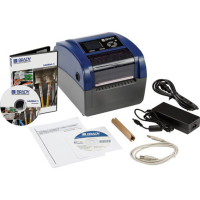Direct Thermal Printing
Direct thermal printers are noted for their simplicity because they print without a ribbon and the direct thermal printed labels typically have a considerably long shelf life but are not well suitable for environments that expose them to long periods of direct sunlight, heat or abrasion. Direct thermal printers have no ink, toner, or ribbon.
If the label is overexposed to heat, light, or other catalysts, the material will darken and make the text or barcode unreadable. For these reasons, direct thermal printing is not used for lifetime identification applications. The readability of direct thermal labels, wristbands, and receipt papers varies greatly, depending on the usage conditions, but the technology provides ample lifespan for many common barcode printing applications including shipping labels, patient and visitor identification, receipts, and ticket printing.
Direct Thermal Printing Advantages
- Direct thermal printing produces sharp quality prints with good scan ability.
- Direct thermal is ideal for applications requiring only a lifecycle — meaning the label image does not need to last very long. Shipping labels and receipts are ideal applications, for instance, while product labels are not.
- Direct thermal printers are simple to operate compared to most other print technologies because there is no ink, toner or ribbon to adjust, monitor or replenish.
- With no supplies to replace other than the material to be printed, long-term maintenance costs remain low, making this a cost-effective way of printing.
- Direct thermal enables batch or single label printing with virtually no waste.
- Recyclable materials available, direct thermal printers offer environmental economy.
- Direct thermal printers are typically built more durably than dot matrix or laser printers, allowing reliable operation in industrial as well as office applications.
Direct Thermal Limitations
Direct thermal printing is extremely sensitive to environmental conditions such as heat and light (fluorescent and / or direct sunlight).
Direct thermal paper remains chemically active after printing. Because of this, thermal labels, tags or ticket stock are often top coated to resist UV light exposure, chemicals and abrasion.
|
What am I printing?
|
Direct Thermal
|
|
Address or shipping Labels
|
X |
|
Wristbands (indoor)
|
X |
|
Receipts
|
X |
|
Tickets
|
X |

